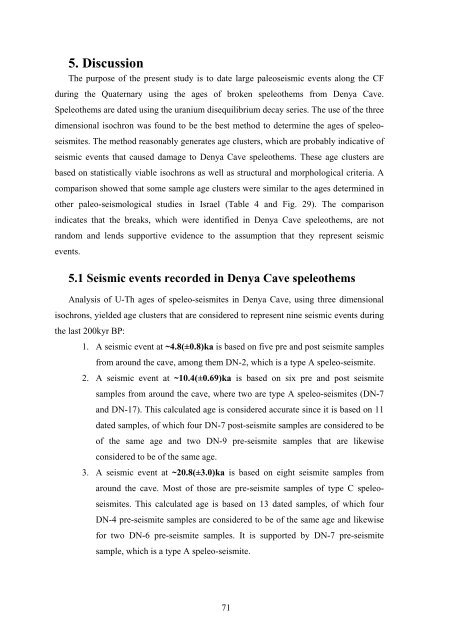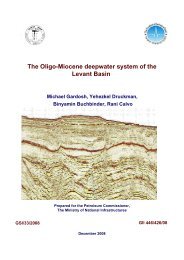tivity on the carmel faul
tivity on the carmel faul
tivity on the carmel faul
Create successful ePaper yourself
Turn your PDF publications into a flip-book with our unique Google optimized e-Paper software.
5. Discussi<strong>on</strong><br />
The purpose of <strong>the</strong> present study is to date large paleoseismic events al<strong>on</strong>g <strong>the</strong> CF<br />
during <strong>the</strong> Quaternary using <strong>the</strong> ages of broken speleo<strong>the</strong>ms from Denya Cave.<br />
Speleo<strong>the</strong>ms are dated using <strong>the</strong> uranium disequilibrium decay series. The use of <strong>the</strong> three<br />
dimensi<strong>on</strong>al isochr<strong>on</strong> was found to be <strong>the</strong> best method to determine <strong>the</strong> ages of speleoseismites.<br />
The method reas<strong>on</strong>ably generates age clusters, which are probably indicative of<br />
seismic events that caused damage to Denya Cave speleo<strong>the</strong>ms. These age clusters are<br />
based <strong>on</strong> statistically viable isochr<strong>on</strong>s as well as structural and morphological criteria. A<br />
comparis<strong>on</strong> showed that some sample age clusters were similar to <strong>the</strong> ages determined in<br />
o<strong>the</strong>r paleo-seismological studies in Israel (Table 4 and Fig. 29). The comparis<strong>on</strong><br />
indicates that <strong>the</strong> breaks, which were identified in Denya Cave speleo<strong>the</strong>ms, are not<br />
random and lends supportive evidence to <strong>the</strong> assumpti<strong>on</strong> that <strong>the</strong>y represent seismic<br />
events.<br />
5.1 Seismic events recorded in Denya Cave speleo<strong>the</strong>ms<br />
Analysis of U-Th ages of speleo-seismites in Denya Cave, using three dimensi<strong>on</strong>al<br />
isochr<strong>on</strong>s, yielded age clusters that are c<strong>on</strong>sidered to represent nine seismic events during<br />
<strong>the</strong> last 200kyr BP:<br />
1. A seismic event at ~4.8(±0.8)ka is based <strong>on</strong> five pre and post seismite samples<br />
from around <strong>the</strong> cave, am<strong>on</strong>g <strong>the</strong>m DN-2, which is a type A speleo-seismite.<br />
2. A seismic event at ~10.4(±0.69)ka is based <strong>on</strong> six pre and post seismite<br />
samples from around <strong>the</strong> cave, where two are type A speleo-seismites (DN-7<br />
and DN-17). This calculated age is c<strong>on</strong>sidered accurate since it is based <strong>on</strong> 11<br />
dated samples, of which four DN-7 post-seismite samples are c<strong>on</strong>sidered to be<br />
of <strong>the</strong> same age and two DN-9 pre-seismite samples that are likewise<br />
c<strong>on</strong>sidered to be of <strong>the</strong> same age.<br />
3. A seismic event at ~20.8(±3.0)ka is based <strong>on</strong> eight seismite samples from<br />
around <strong>the</strong> cave. Most of those are pre-seismite samples of type C speleoseismites.<br />
This calculated age is based <strong>on</strong> 13 dated samples, of which four<br />
DN-4 pre-seismite samples are c<strong>on</strong>sidered to be of <strong>the</strong> same age and likewise<br />
for two DN-6 pre-seismite samples. It is supported by DN-7 pre-seismite<br />
sample, which is a type A speleo-seismite.<br />
71

















